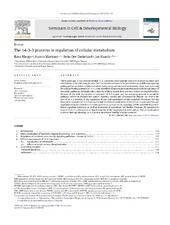The 14-3-3 proteins in regulation of cellular metabolism
Peer reviewed, Journal article
Published version
Permanent lenke
https://hdl.handle.net/1956/9815Utgivelsesdato
2011-09Metadata
Vis full innførselSamlinger
Originalversjon
https://doi.org/10.1016/j.semcdb.2011.08.008Sammendrag
Thirty years ago, it was discovered that 14-3-3 proteins could activate enzymes involved in amino acid metabolism. In the following decades, 14-3-3s have been shown to be involved in many different signaling pathways that modulate cellular and whole body energy and nutrient homeostasis. Large scale screening for cellular binding partners of 14-3-3 has identified numerous proteins that participate in regulation of metabolic pathways, although only a minority of these targets have yet been subject to detailed studies. Because of the wide distribution of potential 14-3-3 targets and the resurging interest in metabolic pathway control in diseases like cancer, diabetes, obesity and cardiovascular disease, we review the role of 14-3-3 proteins in the regulation of core and specialized cellular metabolic functions. We cite illustrative examples of 14-3-3 action through their direct modulation of individual enzymes and through regulation of master switches in cellular pathways, such as insulin signaling, mTOR- and AMP dependent kinase signaling pathways, as well as regulation of autophagy. We further illustrate the quantitative impact of 14-3-3 association on signal response at the target protein level and we discuss implications of recent findings showing 14-3-3 protein membrane binding of target proteins.

